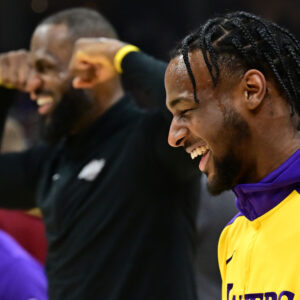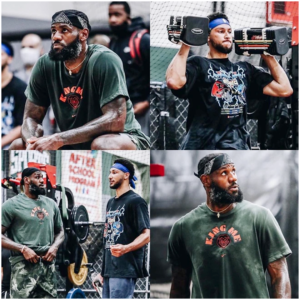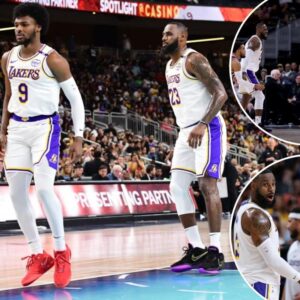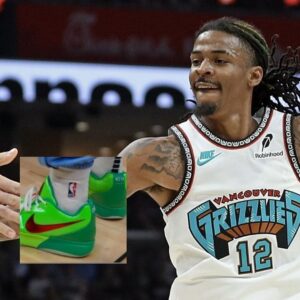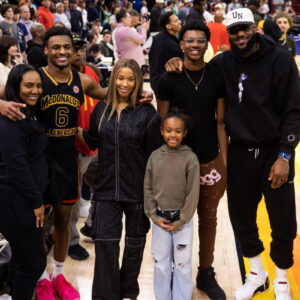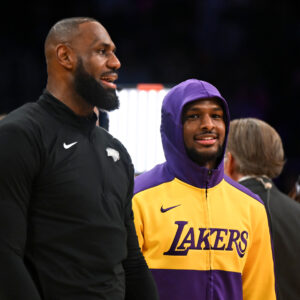KEVIN DURANT HEARD the pop in his right leg over the roar of nearly 20,000 fans inside Scotiabank Arena in Toronto. Then he collapsed to the floor, holding his leg, pinching his heel.
It was the second quarter of Game 5 of the 2019 NBA Finals. As Durant sat there, a member of the Golden State Warriors, memories from his basketball career flashed before his eyes. Fearing the end of his career, or one that seemed recognizable, he gazed around the court and into the crowd, trying to soak up a final moment.
When he was helped to the locker room, Durant’s foot didn’t feel fully attached. Then, a doctor performed what’s known as a Thompson Test to determine the integrity of the Achilles tendon, an essential band of tissue that helps connect calf muscles to the heel. Patients lie face down, with their feet hanging off the edge of a table or a bed, and a doctor squeezes the calf to see if the foot moves. If it doesn’t, then that tendon is likely torn.
Inside the room, the doctor squeezed Durant’s right calf — nothing moved. The doctor looked around at other specialists, at nearby Warriors officials who looked on. The room fell silent. Doubt soon crept in. “This is career-ending, I’m done,” Durant recalled thinking. Even if he came back, maybe he’d only average 15 points a game, maybe a few more — maybe.
“That’s what I was thinking,” he told ESPN, “because that’s all I was hearing, that this s— is over.”
The events of five years ago still serve as a flashbulb memory for Durant. He remembers them vividly.
What followed in the weeks, months and years ahead — a series of tedious milestones, starting with learning to walk again, learning to run again, learning to jump again — represent an unheralded aspect of Durant’s Hall of Fame career: an unrelenting burn to return not just to the player he was, but to one more efficient and effective than before. Each milestone felt momentous and hard-won, and this season, Durant reached another, when he played 75 regular-season games, his first time playing that many since 2018-19.
Now, in his second season with the Phoenix Suns, down 2-0 in the first round of the playoffs to the Minnesota Timberwolves, Durant will be called upon to help save a teetering season, with Game 3 coming Friday night in Phoenix (10:30 p.m. ET, ESPN).
SUNS OWNER MAT ISHBIA went all-in for Durant in February 2023, sending Mikal Bridges, Cam Johnson, four first-round draft picks and a 2028 first-round pick swap to the Brooklyn Nets in exchange for the star swingman. Then, a few months later, the Suns dealt for star guard Bradley Beal.
With their new Big Three of Durant, Beal and star shooting guard Devin Booker, the Suns seemed poised for championship contention, but injuries and uneven play have interfered. Through it all, Durant has been the constant, averaging 27.1 points in 37.2 minutes this season, during which he made his 14th NBA All-Star appearance.
Sitting inside the Target Center in Minneapolis, Durant folded his 6-foot-11 frame into a chair and discussed this latest milestone on his journey. The stands were empty, practice had ended and most of his Suns teammates had departed back to the team hotel.
He had worked so hard to get back, he had felt like his old self by the 2021 playoffs, he said. But then a series of nagging injuries — slipping on the court, or players falling into him — kept him sidelined.
“I felt like I would’ve played 75 games the past two years, to be honest,” Durant said.
As he spoke, he offered a window into an aspect of him that those around Durant describe as rare, if not wholly unique: an obsession and love for the game so intense that they alone carried him through the darkness of an injury that had robbed him of so many weeks, months, years.
“There are very few who love the game as much as KD,” Suns general manager James Jones told ESPN. “You don’t play this long and that well unless you love it. You can’t fake that fire.”
Jones paused. “That’s what I want to say,” he reiterated. “You can’t fake that fire.”
Back inside the increasingly quiet Target Center, Durant continued to reflect.
He was 30 when his Achilles ruptured, well in his prime. He is now 35, in the winter of his career with a couple wisps of gray dotting his goatee. During Game 1 of this first-round series against Minnesota, 22-year-old Timberwolves superstar Anthony Edwards barked at Durant after sinking a series of jumpers over him, and social media accounts tracking their exchange alleged that, among other things, Edwards called Durant “old.” By NBA standards, a literally fair assessment. After all, Durant was drafted and played for a team that no longer exists: the Seattle Supersonics.
Durant looked out at the court.
“It was a long process, man,” he said.
ANDY BARR WAS living in Los Angeles in the fall of 2019 when he received the call.
Durant had undergone surgery to repair his Achilles tendon almost immediately after it snapped. And a couple of months after that, the Nets, whom Durant had joined that summer, asked Barr to start working with Durant.
By then, in 2019, Barr served as a physiotherapist to help professional athletes recover from injury. It was a subject he knew well; a major knee injury derailed his own career as a professional soccer player in England. After that, he shifted his focus toward helping players, first in soccer — including for Manchester City — and later joining the New York Knicks, where he worked for six years as a director of performance and rehabilitation from 2009 to 2015.
Barr had worked with players across all sports who had suffered catastrophic injuries, including rupturing an Achilles tendon, and he knew how challenging, both physically and mentally, it could be to recover.
After all, Achilles tears have long cleaved professional sporting careers — from what a player was, to what the injury reduced them to, the gap often hauntingly wide.
Because of that dynamic, Barr said that much of his job during the rehabilitation process surrounds managing those anxieties: What if I don’t heal right? What if I’m never the same? What if I’m never good again? What if my career is over? What else am I going to do with my life?
Those nagging questions can hinder a player’s progress through the mind-numbing days of rehabilitation, repeatedly performing menial exercises, rebuilding strength toward a return date that might never exist.
“It’s tough,” Barr told ESPN. “You’ve really got to be there for them during that process.”
DURANT IMMEDIATELY STRUCK Barr as being different.
“It was incredible,” Barr said. “From day one, he was just ultimately focused and determined to get back.”
But it was far from easy — or immediate.
“I don’t want to say I was depressed, because depression is its own thing, but whatever is under depression,” Durant said. “There was something mentally that was going on. That’s a dark place. We all think we’re these god-like beings. I couldn’t tell the future. I didn’t know what the f— was next. I didn’t know how I was going to look or feel or play.”
He thought of Kobe.
“When Kobe went through his, I just thought, ‘There’s no f—ing way that Superman tore his Achilles,” Durant said. “You never think it could happen to players like Kobe Bryant or even to me. It’s just such a career-ending injury.”
Durant relied on Barr and other specialists to put his racing mind at ease.
For four years, the two worked together, with Barr, whom the Nets hired as a consulting physiotherapist, taking a red-eye flight from Los Angeles to New York almost every week — leaving on a Sunday night and returning to L.A. on Fridays. Depending on the team schedule, they’d work together nine-to-five on some days but 9 a.m. to 10:30 p.m. on others.
Durant never missed a day.
“Nothing was ever like, ‘I’m going to bulls— around,'” Barr said. “He just goes out there with pure purpose.”
“My whole being has been committed to playing basketball. I didn’t think it was time yet. It’s that simple,” Durant said. “And when I’m that committed to something, I didn’t even think about anything else but, like, when are we starting recovery? As soon as it happened, everybody wanted to cry with me. I did that for a second, crying, because everybody else was crying, and then I’m like, ‘When are we doing surgery? When can I start my recovery process?’ And that’s how it was, man. I’m ready to get back, quick.”
It was refreshing, Barr said, if unusual, especially for a player of that caliber. He had worked with some players, even stars, and he had to convince them to do certain exercises, to show effort, to care. And Barr would think to himself, “Why the hell do I have to convince you to do something to get better?” But he would explain something to Durant, and Durant would respond, almost robotically: “OK, how many sets and repetitions?” Then, he’d execute them.
“He’s so self-motivated,” Barr said. “It was amazing. He just makes my job so easy.”
They talked about life beyond basketball. “He was teaching me about his world,” Durant said. “I was teaching him about the mentality of basketball players.” The goal was to help Durant return to his former state but also become more purposeful with how he moved.
It was an education.
“I was working with the [resistance] bands,” Durant said, crouching down as if they were still placed on the outside of his legs, “and the first thing I was doing movement-wise, I would jump off a box, get into a stance with bands on. Like, what the f—? Like, truly, tell me what this means? Every time we were doing something, I’d be like, ‘Am I doing this right?'”
Barr would explain how that movement was the beginning of a full-body effort to slide; they were just breaking it down to build it back up.
“An Achilles injury is like a double-edged sword,” Durant said, “because you can learn so much about who you are, your body, how it works, because that’s a major, major ligament.”
Throughout the years, Barr would often watch Durant and wonder why he was putting in that level of effort. Why did he care so much? “He had already done everything,” Barr said. A multiple-time NBA scoring champion. An NBA MVP. A two-time NBA champion. A two-time Finals MVP. A six-time All-NBA first-team member. Countless NBA All-Star appearances. Multiple Olympic gold medals.
“He’s committed to constantly developing himself,” Barr said. “He’s not bothered by anyone else. It’s, How can I get better every single day? And he’ll do that until he can’t do it anymore. He’ll do that until he’s 90.”
Barr came to that realization watching Durant on a daily basis.
“You’ve got players who play until they get rich, then they can take their foot off the gas,” Barr said. “Then you’ve got players who love playing and the money is a reward for them loving it. He just loves the game. He’s obsessed with it. And there’s not too many players like that. They may like it, they may be good at it, but he loves it.”
This is the most common refrain around the Suns when asked about Durant and his long road back.
“He’s one of the all-time gamers,” Suns coach Frank Vogel told ESPN. “He’s someone who always wants to be in there.”
Said Jones, “He’s made a concerted effort to play every game. He just attacks every day with the intention of playing. That’s lost on guys. That’s what people forget about the greats — is that basketball is their life. Every day, he’s doing something to push himself.”
Durant led them with a team-high 31 in their Game 1 loss to Minnesota on Saturday. During a third-quarter run in which Durant drained several midrange jumpers in a row, Edwards, the Timberwolves star, found himself watching his favorite player in awe. “I became a fan at one point,” Edwards said after his team’s win. “I was out there like, ‘Goddamn, he nice.'”
STANDING AGAINST THE stanchion at the Suns’ practice facility, Durant said it was not simply his love for the game that fueled his return. For him, it felt far more existential.
“I think all these guys love it,” he said. “It just feels like life or death for me since day one growing up. If I wasn’t doing this, what the f— else am I doing? Until the wheels fall off. I can’t just not be the best basketball player that I can be every day. That’s been the mentality in my head since I was 8 years old.
“I had no other choice but to go back to work. I wasn’t going to go back and be like, ‘Mom, Dad, Bro, Sis, Godfather — all my whole family that has been trusting in me and believing in me that I’m living for and I’m pushing this family name for every day — [and say] ‘I’m done, I tore my Achilles.’ Like, what the f— you mean? You’re done? You can’t be done.”
For years, Durant maintained a list of milestones. “Early in the process, it was learning to walk on two feet again,” he said. Walking, then jogging, then running, then shooting jumpers going right, when he’d jump off that leg.
But he also had to be patient. He started walking in a pool once and felt soreness in his Achilles the next day; it was time to slow down.
“It’s a tedious process, man, where you have to really, really monitor your body every … single … day,” Durant said.” And every moment matters, every second matters when you’re trying to recover from that injury.”
When he made his debut for the Nets in a December 2020 preseason game, his first outing since the Achilles injury, a span of 552 days had passed. One minute into the game, he drove down the lane and dunked. He finished with 15 points, 3 rebounds and 3 assists in nearly 24 minutes. It was, by any measure, a resounding success, but Durant still carried so many questions.
“How am I going to feel in a regular-season game? How am I going to feel in a high-pressure fourth-quarter game? And then, how am I going to feel in a playoff game — in a Game 6, a Game 7?”
“I was just setting milestones as I go,” he said, “and never feeling satisfied with where I was at the time and just wanting to experience more and putting more stress on my Achilles, so I can say, all right, I’m finally back now.”
That feeling — that long-awaited return — arrived just six months later, when the Nets faced the Milwaukee Bucks in the second round of the 2021 playoffs. Durant averaged 35.4 points across nearly 43 minutes in the riveting seven-game series, which the Bucks won despite a 48-point effort from Durant in Game 7.
After that series, Durant told himself, “OK, this is who I am.”
He was finally back.
Setbacks still limited him, but there was nothing lingering from the Achilles; that was behind him.
Perhaps the most striking part of Durant’s rebound and durability this season — after everything that preceded it — is that his durability was arguably the biggest question mark around Durant before he entered the NBA. Durant was famously criticized after not being able to bench-press 185 pounds at the pre-draft combine in 2007. He was criticized for having a string-bean build. The game plan, as he’s come to know too well, was to play physically against him.
“That’s the scouting report — to be as physical as you can,” Durant said. “You’re running into four to five players on every possession since I was 22, 23 years old, so I’ve built up a callus to get hit, a callus to get elbowed and hop back up.”
Just then, an odd connection revealed itself. The biggest criticism of Durant would prove, he explained, to be a huge benefit for him.
“Being played physical my whole career,” he explained, “kind of helped me bounce back and be able to take some of these injuries that I’ve had.”
As he talked, Durant leaned forward and tapped parts of his body, pointing out where repeated blows have helped him develop his own personal sort of armor. Then, one of the NBA’s all-time gamers leaned back, pleased but never satisfied.
